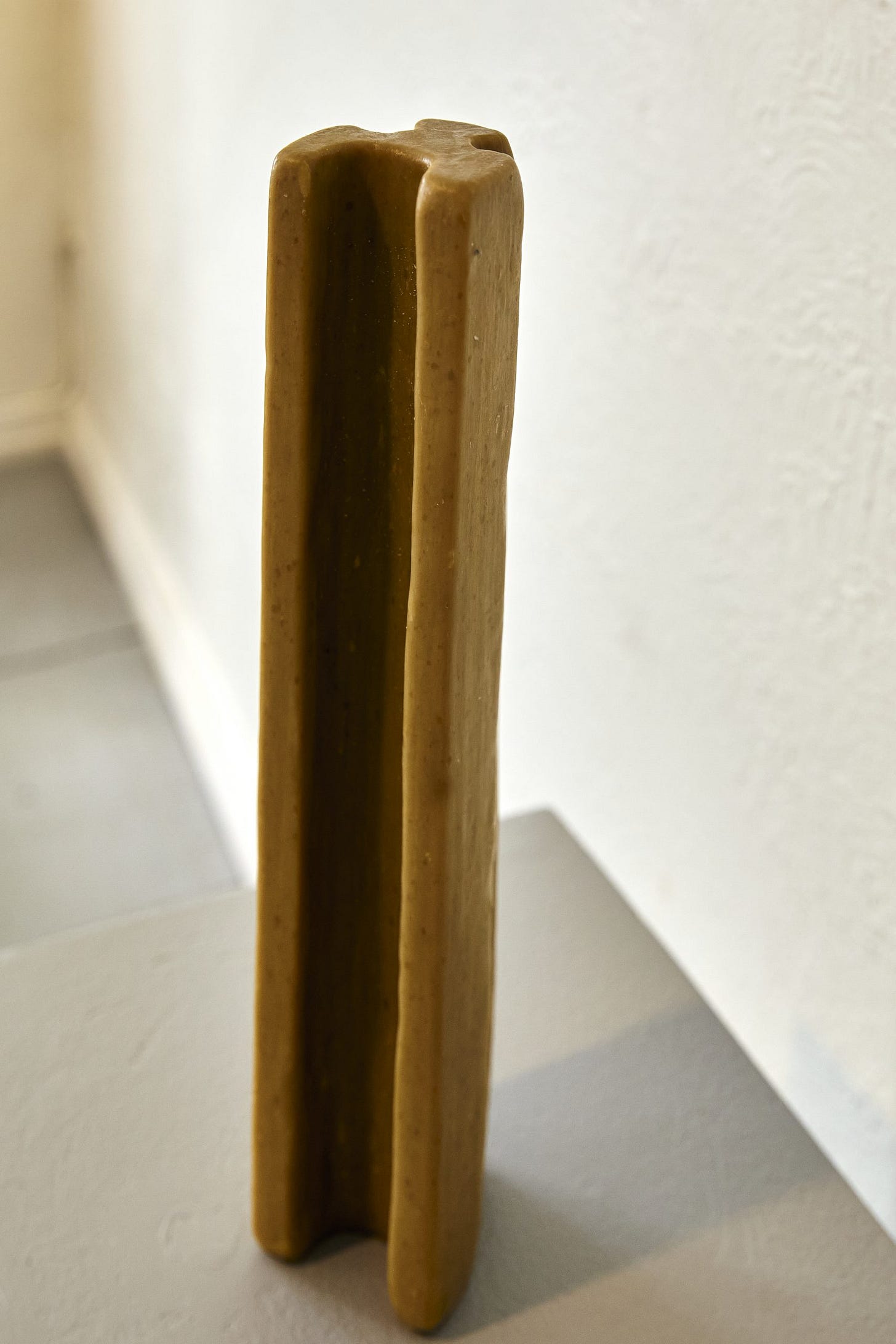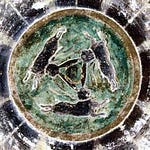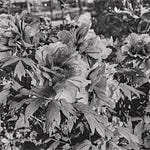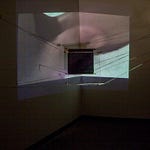"Structure, in the making and demolition of form, when brought into light with the human relationship with environment makes outcomes of social relationships evident to me. The description of toxic masculinity can be ascribed to the absence of masculinity. The exhausting petulance of progressive ideology has an emotional labor that seems to justify the self-proclaimed and righteous feminist. There are always costs and risks associated with any temporary benefit. The necessity for difference and discernment relative to constancy and healthy change has been fashioned into an ideological feedback loop with a populace unwilling to reconcile the consequences such ideologies have on life. In that I am interested in structures that endure, perhaps only in the intimate moments of grief, do humans reflect on the memory of what their actions cause." -Mari Amman
Y-Blokka, Olive Oil Soap. Why should I know anything? I survived the effects of the mental perversion and managed to live to share with anyone who may dare to care. The fastest reaction to thinking that doesn’t have us nodding along as bobble heads usually has been to deny, deflect, reject, and so forth. Do what you want with the information. Please avoid accosting the messenger, that’s stale and would be just so Judas of you. Further medical research is below. There are a great number of reputable resources available. In fact, science is required to be done in public. This is part of the ethics required of the scientific method.
Y Form, Biological Reference
Definition: noun, plural: immunoglobulins. (1) Any of several classes of structurally related glycoproteins in the blood serum, produced by plasma cells as an immune response against foreign agents (antigens); antibody. (2) The fraction of the blood serum containing antibodies.
Supplement: An immunoglobulin (Ig) is a glycoprotein; it is comprised of a glycan and a protein constituent. The basic functional unit of an immunoglobulin has a Y-shape. It consists of two identical heavy chains and two identical light chains. In each of these chains, there are variable and constant regions. The apical portion of the variable regions serves as antigen-binding site. The plasma cell produces immunoglobulins as a response to an antigen, i.e. non-self foreign agent. The immunoglobulin may also be described in this way: it is composed of two Fab (fragment, antigen-binding) regions and one fc (fragment, crystallizable) region. The Fabs include the antigen-combining sites whereas the fc region consists of the remaining constant sequence domains of the heavy chains, cell-binding site, and complement-binding sites. In placental mammals (including humans), there are five classes (or isotypes) of immunoglobulins based on structure and biological activity.
SS-B/La Antibodies, IgG, Serum Reporting Name: SS-B/La Ab, IgG, S, Useful for: evaluating patients with signs and symptoms of a connective tissue disease in whom the test for antinuclear antibodies is positive. Testing for SS-B/La antibodies is not useful in patients without demonstrable antinuclear antibodies.
Clinical Information: SS-B/La is an extractable nuclear antigen (ENA) composed of a 48-kD protein combined with RNA species. SS-B/La antibodies are found primarily in patients with Sjogren syndrome or lupus erythematosus (LE), where they occur with frequencies of approximately 60% and 15%, respectively.(1,2) SS-B/La antibodies occur only infrequently in the absence of SS-A/Ro antibodies. SS-B/La is 1 of 4 autoantigens commonly referred to as extractable nuclear antigens (ENA). The other ENA are SS-A/Ro, RNP, and Sm (Smith). Each ENA is composed of 1 or more proteins associated with cytoplasmic or small nuclear RNA species (snRNA) ranging in size from 80 to 350 nucleotides. Antibodies to ENA are common in patients with connective tissue diseases (systemic rheumatic diseases) including LE, mixed connective tissue disease, Sjogren syndrome, scleroderma (systemic sclerosis), and polymyositis/dermatomyositis. See Connective Tissue Disease Cascade (CTDC) in Special Instructions.
Interpretation: A positive result for SS-B/La antibodies is consistent with connective tissue disease, including Sjogren syndrome and lupus erythematosus.
Testing Algorithm: See Connective Tissue Disease Cascade (CTDC) in Special Instructions.
Clinical Reference: 1. Homburger H, Larsen S: Detection of specific antibodies. In Clinical Immunology: Principles and Practice. First edition. Edited by R Rich, T Fleisher, B Schwartz, et al. St. Louis, Mosby-Year Book, 1996, pp 2096-2109
2. Kotzin B, West S: Systemic lupus erythematosus. In Clinical Immunology Principles and Practice. Second edition. Edited by R Rich, T Fleisher, W Shearer, et al. St. Louis, Mosby-Year Book, 2001, pp 60.1-60.24
Method Name: Multiplex Flow Immunoassay
Specimen Type: Serum
Specimen Required: Container/Tube Preferred: Serum gel; Acceptable: Red top; Specimen Volume: 0.5 mL
Specimen Minimum Volume: 0.35 mL
Specimen Stability Information
Specimen Type
Temperature
Time
Special Container
Serum
Refrigerated (preferred)
21 days
Frozen
21 days
Reference Values
<1.0 U (negative)
≥1.0 U (positive)
Reference values apply to all ages.
Test Classification: This test has been cleared, approved, or is exempt by the US Food and Drug Administration and is used per manufacturer's instructions. Performance characteristics were verified by Mayo Clinic in a manner consistent with CLIA requirements.
CPT Code Information 86235
LOINC Code Information
Test ID
Test Order Name
Order LOINC Value
SSB
SS-B/La Ab, IgG, S
33613-1
Result ID
Test Result Name
Result LOINC Value
SSB
SS-B/La Ab, IgG, S
33613-1
Mayo Clinic Laboratories | Neurology Catalog Additional Information: mml-Behavioral, mml-Epilepsy, mml-Headache, mml-Movement-Disorders, mml-Demyelinating-Diseases, mml-Neuroimmunology, mml-Neuromuscular, mml-Autonomic, mml-Pediatric, mml-Spinal-Cord, mml-Neuro-ophthalmology. https://neurology.testcatalog.org/show/SSB













